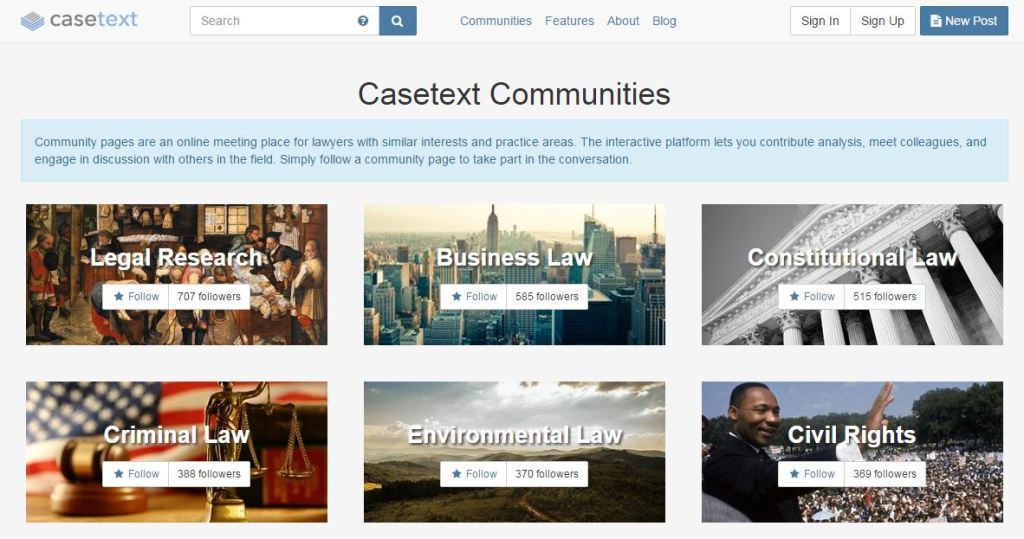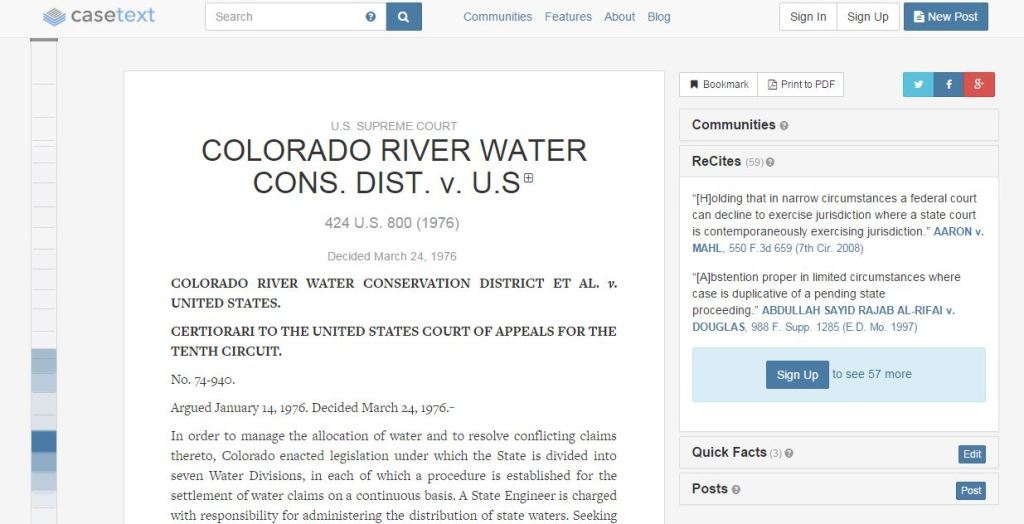Crowdsourced legal research site Casetext officially rolled out its new community pages this week. Designed to provide common ground for lawyers who share interests and practice areas, these pages allow lawyers to contribute analysis, meet others in their fields, and engage in discussions about current legal developments.
Also this week, Casetext announced new features, added new cases, and added new forms of content that will help provide greater perspective on the cases. I’ll get to these later in this post, but first more about the communities.
In July, I previewed the beta version of Casetext’s communities in July. Now that this feature is out of beta, much of what I wrote then remains true.
The communities are structured around legal practice and interest areas, such as environmental law, business law and legal research. These are designed to be places where legal professionals can find and interact with others who share their interests. The discussions that take place here will be linked to the cases they discuss, and the cases will link to the discussions.
Once a user decides to follow a community, the user will then receive a feed of all updates to that community. Users can post updates directly from the community page or from a case page. Say, for example, you are reading a case involving environmental law. If you decide to post a comment or annotation to the case, you can tag the comment with the community name and it will appear in that community’s feed, as well as with the case. (You can tag comments to multiple communities, if relevant.)
Once a comment is posted, others can respond and begin a discussion. Other members can also share your comment through their social media networks or by email.
There are 41 of these communities. In addition to the topics I mentioned above, others include constitutional law, civil rights, tech law, appellate practice, legal ethics, privacy and cybersecurity, maritime law and Native American law.
During the beta phase, Casetext focused its greatest effort on building up the environmental law section, as a model for what the others could be. That section will continue to be the focus of the most intense development, as the company works towards securing Series A financing. But the other sections are active and growing as well.
New Content on Casetext
When I first wrote about Casetext in July 2013, its collection of cases included all Supreme Court cases, all federal circuit cases starting from volume one of the F.2d series, all federal district court cases published in F.Supp. and F.Supp. 2d since 1980, and Delaware cases published since Volume 30 of the Atlantic reporter.
Since then, it has been adding additional libraries of state cases. Most recently, it added Massachusetts cases. In addition to Delaware, it also now includes California, Florida, Illinois and Texas, for a total of six states.
Besides cases, Casetext is pulling in other forms of content to help further flesh out the annotations and analysis it provides of cases. For one, it is now aggregating content from a number of leading blogs. Blog posts are linked to any cases they discuss and to any community pages to which they relate. Casetext posts only a snippet of the full blog post and links it to the original source. However, it examines the full text of the blog posts to ensure that posts are linked to any cases they mention.
Another addition is case-summarizing parentheticals. I wrote in July about WellSettled.com, a site that mines judicial opinions for those parenthetical-style statements and phrases that summarize a case (“it is well settled that …”). That site was developed by Pablo Arredondo, Casetext’s vice president, and he has now brought those parentheticals — more than 120,000 of them so far — into Casetext.
Now, when you view a case, a box to the right shows ReCites (rhymes with KeyCites), which are these parentheticals. They provide an easy way to get a quick sense of a case’s most important holdings.
Several other content additions are soon to be added to Casetext. As with blog posts, these will all be linked both to any cases they mention and to any communities to which they relate. New content expected to be added over the next couple of months includes:
- Law firm client alerts distributed via JD Supra. These are articles circulated by law firms to their clients that discuss cases and legal developments.
- Appellate briefs, both collected from online sources and contributed by users.
- Congressional Research Service reports. These reports contain legal research and analysis performed by the Library of Congress for members of Congress. Congress does not allow public access to these reports, but selected reports are available through various websites. Casetext has obtained a large number of these.
New Features on Casetext
In addition to new content, Casetext also this week introduced new or improved features.
One is an enhancement to the search results page. Now, search results include not only cases and posts, but also registered users. If the search term appears in a user’s profile, that user appears in a new “Users” section of the results page. This provides a way for users to find other users who are knowledgeable about a topic.
Another is an improved “heat map.” As I noted when Casetext first introduced this last March, the heatmap runs alongside each case and shows how frequently each page has been cited. That lets the researcher jump to the most important parts of a case. The heatmap now appears directly along the left side of a case and its coloring has been changed to better show the frequency of citations.
Casetext remains completely free to use. You do not need to register to search cases. You do need to register if you want to be able to post comments and vote on others’ comments.
A paid version is available for law firms and organizations that want to securely integrate their own private content with Casetext’s database of legal documents and user submissions.
If you’ve never tried Casetext, I urge you to do so. And when you do, share what you think about it in a comment here.
 Robert Ambrogi Blog
Robert Ambrogi Blog
